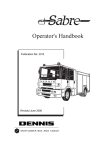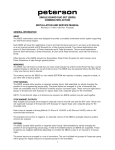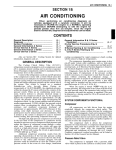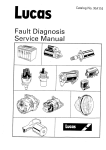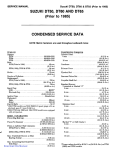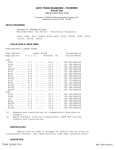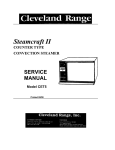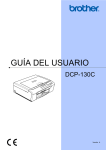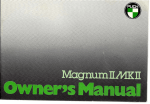Download Lucas Vehicle Wiring Circuits Technical Service Manual
Transcript
/cC i-i.C. % Classic Cars & Cycles www.ClassicCycles.org TECHNICAL SERVICE ee Fr OVERSEAS TECHNICAL CORRESPONDENCE ow D COURSE Section 6 nl d oa VEHICLE WIRING CIRCUITS Classic Cars & Cycles www.ClassicCycles.org INTRODUCTION Ignition circuits. ee Fr The electrical circuit of the modern automobile can appear most complex to the uuinitiated. Careful study however, of the wiring diagrams produced by the Lucas Organisation and the Vehicle Manufacturers will allow the student to study the various circuits both individually and as a whole. The study of each circuit separately before tackling the complete job, is perhaps the best method for the student to adopt, as with few exceptions the electrical system of a motor vehicle can be considered as a series of simple circuits, as for example the Lighting, Charging and Having grasped the fundamentals of these circuits it is then possible to consider as a whole the complete Wiring Harness or Wiring Loom. oa nl ow D Motor vehicle wiring has been, and continues to be, subject to many changes, mainly to facilitate speed and convenience on the vehicle assembly lines. With the introduction of snap connectors and separate junction boxes, cable assemblies can now be made up as subsidiaries to the main loom. This considerably assists the manufacturer, whose vehicle in these days of mass production, is often produced at separate branch works in the form of units, i.e. engine, chassis and body, before final assembly. It will be readily seen therefore, that these harness sub assemblies play an important part both in the initial layout and later in service where rewiring of a damaged section becomes necessary. d Let us now consider the means of idenliGcation of this multiplicity of cables. As we have stated, the electrical system is a series of simple circuits, each consisting of the component, its switch and three wires, feed, switch wire and return. The Lucas colour scheme of identification for British cars is based upon this principle. Feed wires carry braiding of a main colour only, switch wires have a main colour of feed with a coloured tracer woven spirally into the braiding and return or earthing leads are black. These then are the basic principles which will be enlarged upon in the following pages of this section of the course. For the administrator and store keeper the sections dealing with cable sizes, their current carrying capacity, protective sleeving, rubber grommets will be found invaluable as a general guide when considering the materials to stock, particularly where the rewiring of vehicles is an essential part of the service offered. In compiling this section on wiring circuits, as installed on modern British cars, we have reduced the technicalities of the subject to a level that should be easily understood by all students. Page 2 Classic Cars & Cycles • www.ClassicCycles.org CONTENTS PART 1. Wiring Principles — Simple Wiring Circuit — Earth Return System. Negative Earth System — Positive Earth System Connecting Up and Terminal markings. Methods of wiring. Cable looms — Junction boxes. Types of cable in use. Starter cables — Ignition cables. Current carrying capacity. PART 2. > Individual Wiring Circuits — Circuit Identification. ee Fr Typical wiring circuit. Wiring diagrams. Starter circuit — Manual switch — Relay switch. Ignition circuit — Charging circuit. Ignition warning lamp. Rear lighting — Head lighting — Panel lighting. Driving lamps — Fog and Reverse lamps. Auxiliaries — Trafficators — Screenwipers. Fuel gauge and petrol tank unit. D nl ow PART 3. Rewiring in Service. Cable stocks — Sizes — Colours. Protective sleeving. Snap connectors — Junction boxes. Methods of rewiring. oa Partial rewiring — Complete rewiring. d QUESTION AND ANSWER PAPERS STUDENTS QUERY PAPER AIR MAIL REPLY ENVELOPE COPYRIGHT AH rights reserved. No part of this publication may be reproduced without permission. JOSEPH LUCAS (SALES & SERVICE) LTD., BIRMINGHAM, ENGLAND. Page 3 PART ONE Classic Cars & Cycles www.ClassicCycles.org Wiring Principles SIMPLE ELECTRICAL CIRCUIT FEED The typical electrical circuit as we know it com prises any component, such as a lamp for example, connected to a supply — which may be a battery — by two wires or cables ; a feed-wire and a return. Any electrical installation employing this arrangement is pos O known as an insulated return system, and for some time the electrical equipment on vehicles followed this NEC. Q principle. EARTH SYSTEM RETURN An alternative arrangement suitable for many applications, uses an insulated cable as a feed wire to the component, the return being obtained via earth, INSULATED RETURN SYSTEM which on a vehicle is of course the steel chassis. Such an arrangement reduces both the amount of cable necessary and the complexity of the wiring for many of the larger vehicles such as passenger- circuits. carrying and certain heavy commercials, which include petrol carrying vehicles, tht'insidated return system is This single pole or earth return system soon became standard practice for vehicle work in general. But FEED Fr o NEGATIVE EARTH SYSTEM With the earth return system the orthodox arrange ment was to earth the negative pole of the supply, and this became known as the single pole negative earth system, which was used for vehicle work for several years — on British vehicles up to about 1936. ee 6 7777777777777777 EARTH SYSTEM It was then found that certain specific advantages were obtained by earthing the positive pole of the battery instead of the negative. Thus we had the introduction of the positive earth system, which is almost universally used to-day, except for those specialised vehicles previously mentioned. Oue of the main advantages gained by earthing the positive side of the supply is that the polarity of the spark plug central electrode is made negative, which results in improved spark plug performance and longer service life of the spark plugs and the H.T. cables. At the battery itself the formation of electrolytic sulphation at the positive lug is reduced, and also the marked tendency to electrical leakage from the cells to earth, the result of the presence of acidulated nl FEED oa keg O d > POSITIVE EARTH SYSTEM ow D CHASSIS RETURN NEGATIVE still used. moisture. CHASSIS RETURN 7777777777777777 POSITIVE EARTH The corrosion effects at switch contacts, cable connectors, soldered joints, etc. are also reduced, especially under conditions of excessive humidity. SYSTEM FEED CONNECTING UP AND TERMINAL MARKINGS A point to be remembered is that this reversal of polarity makes no difference whatsoever to the working of the system or testing for faults, but it has to be borne in mind when fitting the batteries and connecting up cables. Terminals are all properly marked without reference to the polarity, as shown in our picture, i.e. the dynamo and field terminals D and F. (The D terminal being the larger of the two). /7777777T77777777 POSITIVE EARTH RETURN Page 5 Classic Cars & Cycles www.ClassicCycles.org METHODS OF WIRING Now we come to the cables and the method of wiring which is generally by means of a harness. We shall confine ourselves to British vehicles, although most others follow the,same general pattern. Our picture shows a wiring loom in course of manufacture. 0 Multi-coloured cables are employed as a means of facilitating assembly both at the electrical manufac turer's works, and also on the vehicle makers' assem bly lines. Next, the cables are grouped together and braided into looms with individual conductors emerging where required, thus forming main, branch and trunk cables. Tbe development of this arrangement not only facilitates assembly but also provides considerable protection against chafing on metal edges and sub sequent wiring faults in service. Additionally, sub-assemblies such as the complete car body, or say a steering column may be fully assembled and wired before, being positioned on the vehicle. To facilitate the fitting-up, various junction boxes and snap connectors are now widely used. « ee Fr 5I/.RICS f::5H CABLE LOOM On some vehicles one complete wiring loom may be used ; on others as many as four separate looms — these are finally connected up to the main loom by means of snap connectors or junction boxes. Alto gether there is a vast variety of wiring looms made up ow D one main and two or three subsidiaries are needed and for different makes and models. d oa nl So, unless the vehicle is specially laid out, the stocking and general use of wiring looms is not practicable. For this reason the renewal of damaged wii'mg is more easily and economically handled in service by putting in single cables and employing either junction boxes or snap connectors to rejoin to the undamaged parts of the existing loom. JUNCTION BOXES AND CABLE CONNECTIONS For general purposes, a range of junction boxes and cable connectors is freely available. The snap or spring connectors shown, greatly facilitate re-wiring and general service work. They are made in numerous combinations. These spring connectors must be borne in mind when fault finding. Page 6 gjkA Classic Cars & Cycles www.ClassicCycles.org TYPES OF CABLE IN USE Now before going into circuits and colour schemes, let us examine the types of cables which should be available before embarking on any vehicle wiring repair work. 2. Car wiring cables, of which there are four popular sizes and as many colours as can be conveniently slocked by the average motor trader. 3. Ignition cables which are subdivided into two types : (a) High tension cable, i.e. for spark plugs, etc. (b) Low tension cable, for primary, or low voltage They fall into three groups : I. Starter cables, of which there are three sizes. circuits. STARTER CABLES 1. The most generally used pattern is a fairly light type of jute covered cable as shown. This com prises 37 strands of No. 20 SWG tinned copper wire. It is suitable for most light vehicle work where the starter motor current does not exceed 400 amperes. 3 STARTER CABLES 2. Used in conjunction with this is a similar size earth braid which should always be fitted between engine and chassis as a bonding strip when rubber engine mountings are used. 37/20 This standard braid is also suitable for use as the EARTH BRAID Fr earth lead from the positive terminal of the battery to the earth connection on the scuttle or chassis. •••• 61/18 & 61/20 3. The two heavier starter cables are of similar con ee struction to the light one, i.e. jute covered, but have strip and also as the battery earthing lead. CIRCUIT WIRING CABLES ow D 61 strands of No. 20 or 18 SWG, and are used for starter currents up to 700 amps. Where this size cable is used for the starter supply, further lengths should be made up as a bonding Next we come to the cables necessary for general on the market as auto-cable. is the most convenient size. It should be realised that this is only a general guide New d 28/-012—14 AMPS There art five sizes of cable altogether in general use on the 12 volt system, but for most purposes three are commonly used. These are :— 1. The battery feed circuit cable, comprising 44 strands of -012 copper, generally described as 44/012. This cable has a current carrying capacity of approximately 22 amperes. 2. Main generator or head lamp circuit cables, com prising 28 strands of -012 copper (28/012) with a current carrying capacity of 14 amperes. For most purposes this is adequate. 3. Side and tail lamp wiring, accessory, ignition and generator field circuits comprising 14 strands of •012 copper (14/012) with a current carrying capacity of 7 amperes. 4. For panel lamp wiring and other incidentals a cable comprising 9 strands of 012 copper (9/012) to the cables used in the different circuits. 65 & 44/-012—22 AMPS oa O prise a number of copper strands in rubber and fabric sheaths, specially treated to be highly resistant to petrol, water and oil. Such cables are freely available nl wiring on the vehicle. These are all special cables for the work, and com 14/012—7 AMPS 9/-012—4 AMPS vehicles with Lucas wiring are carefully studied to determine the correct cable sizes. Where long lengths of cable arc used, a larger gauge wire may be necessary to prevent excessive voltage drop. For example, a vehicle with an exceptionally long cable run for the battery feed, six feet or more, may be installed with an oversize cable, such as 65/012. If at any time this cable has to be renewed, a similar size replacement should be installed. This last ruling also applies to re-wiring on vehicles equipped with the 6 volt system, particularly if voltage drop trouble is encountered. Page 7 Classic Cars & Cycles www.ClassicCycles.org EQUIVALENT CABLES — CURRENT CARRYING CAPACITY It may be useful to examine how the cable sizes which have been given, compare with similar cables identified by other standards of measurement. Some CAR TYPE CABLES cable manufacturers describe their cables in terms of » 9/012 (30 SWG) EQUIV. 23/36 14/012 (30 SWG) EQUIV. 40/36 strands of 30 SWG wire or 100 strands of No. 36 28/012 (30 SWG) EQUIV. 70/36 SWG, ail having the same cross sectional area of copper which determines the amount of current 44/012 (30 SWG) EQUIV. 100/36 standard wire gauge and this illustration shows the equivalent sizes which will carry the same amount of current. For example :—Our 44/012 will compare with 44 which can be carried with a specified minimum voltage loss, i.e. voltage drop. IGNITION CABLES Fr 1. The 7 m/m high tension rubber cable is generally used for spark plugs and distributor or magneto ee leads. UM837 Rubber. Neoprenc covered. Oione tested. Resistant to . Heat Oil and Water. grades of this widely used but it is always good policy order to obtain maximum This avoids failures as a and cracking, which may cause elusive and annoying misfiring or, perhaps, complete breakdown. The top three cables shown in the illustration are Lucas H.T. cables which all use Neoprene outer casings. This material has proved to be the best possible protection against heat, oil, petrol and nl ow D There are numerous cable at varying prices, to buy high quality in durability in service. result of deterioration water. 2. The 4 and 5 ra/m low tension cables, which will carry up to about 7 amperes, are widely used for motor cycle work and are equally suitable for any exposed working conditions, where the cable is not d 4mm/5mm Low Tension. 7mm High Tension. oa Special Purpose 7mm Highgloss Braided. subjected to oil or petrol. We have mentioned altogether ten cables, com mencing at the heavy type starter cable carrying up to 700 amperes, and finishing with the 4 and 5 m.m. mainly used on motor cycles. These ten different sized cables, together with earth braid, constitute the minimum range which should be stocked for general motor work. PageS PART TWO Classic Cars & Cycles www.ClassicCycles.org Individual Wiring Circuits THE WIRING CIRCUITS Whilst a car wiring layout as a whole may appear complicated at first sight, the complete arrangement may be broken down into separate circuits as 2. The Ignition Circuit. 3. The Charging Circuit. follows :— 4. Lighting Circuits. 1. Battery and Starter Circuits. 5. CIRCUIT IDENTIFICATION —BATTERY, appropriate coloured tracer. Accessories Circuit. IGNITION AND CHARGING To distinguish these circuits, a distinctive colour scheme is used. all services. The value of such a colour scheme on the car assembly line is obvious, and, once it is understood, it is of equal value in service fault finding. So before wc discuss all the wiring circuits we must know about the colours employed. Eight basic colours are used as follows, with an 2. White for the ignition circuit, and all component feeds which are essential when the ignition is switched on. 3. Yellow or yellow with coloured tracer is used for the aenerator and field circuit. ee Fr 3 1. Plain, brown cable or brown with coloured tracer in it, is used as the current supply or feed wire to LIGHTING D CIRCUIT IDENTIFICATION. AND ACCESSORIES 7. Green is used for the auxiliary circuits which are fed through the ignition switch and protected by a ow 4. Red for the side and tail lamp circuits, starting from the lighting switch. 5. Blue for the headlamp lighting circuit, also starting from the lighting switch. 6. Purple is used for the auxiliary circuits which are fed from the ammeter and protected by a fuse A2. fuse, A4. 8. Black is used for the earth circuit. That is, if a oa nl component is not fixed directly to the chassis, a cable must be taken to a good earthing point on the chassis, and this cable will always be black. d o THE TYPICAL WIRING CIRCUIT We can now deal with the wiring circuits as applied to modern vehicles. Generally, the electrical system of a motor vehicle can be considered as a series of simple circuits, each consisting of the component (1), its switch, (2), and three wires, comprising the feed, switch wire and return (3), this return being provided by the frame of the vehicle, although, in the case of components insulated from the chassis, an earthing lead is also RETURN necessary. Some variations are to be found, such as fuses, twoway switching and so on, but the principle of feed wire, switch wire and return remains, and it is upon this that the Lucas wiring colour scheme is based. Feed wires carry braiding of a main colour only. Switch wires have the main colour of feed with a coloured tracer woven spirally into the braiding. return or earthing leads are black. 111111111) 111 r.TT The Page 9 Classic Cars & Cycles www.ClassicCycles.org mens ELECTRICAL EQUIPMENT HOME AND EXPORT MODELS THE STANDARD WIRING DIAGRAM Here we have a typical wiring diagram of which there is one published for most models and makes of vehicles. These diagrams are of considerable value in service, but a certain amount of difficulty may be experienced by the non-specialist in following them out. Fr ee It is however, quite simple if each component circuit is considered in dividually which we shall proceed to do, commencing with the starter system. TO CAIlE ow D KEY COLOURS WIRING DIAGRAM nl 12 VOLT. 19-48 FOR SPECIFICATION OF JQUIfMIMT I El OVERLIAf. d oa ISSUED: 1 UNE COMMON BATTERY SUPPLY CIRCUIT The current supply for all circuits on the vehicle commences either direct from the battery negative terminal, or from the battery side of the starter switch. It comprises a heavy brown cable, first running from the battery to the control box ' A ' terminal, and through the load windings of the regulator to the terminal ' Al.' From here a brown and blue cable leads to the lighting switch where it loops off to one side of the ignition switch (terminal ' A '). If an ammeter is installed, it will be placed in the brown lead between the source of supply and the control box ' A ' terminal, the cable becoming brown and white between the ammeter and the control box. THE BATTERY SUPPLY CIRCUIT. Page 10 Classic Cars & Cycles www.ClassicCycles.org THE STARTER CIRCUIT—WITH MANUAL SWITCH o The first and most elementary circuit is that of the starter motor system. This motor can be either manually or solenoid operated. Our picture shows the manually operated starter motor circuit. The current path is from the negative terminal on the battery to the starter switch (1), across the switch contacts to the insulated terminal on the starter motor (2), through the starter to the engine block, then via the bouding strip to the chassis (3), returning to the positive terminal of the battery via the battery earth cable (4). The earth cables 3 and 4 are most important to the successful operation of the starter, particularly under cold starting conditions and must always be well maintained. Where a solenoid starter switch is fitted, an addi tional relay circuit is introduced. STANDARD STARTER WITH MANUALLY OPERATED SWITCH o Fr THE STARTER CIRCUIT-SOLENOID ee (RELAY) OPERATED In this arrangement of the main starter circuit we have to add a solenoid operating circuit, and this is under the control of the ignition switch. That is, the starter solenoid can only be operated with the ignition Firstly, there is the common supply from the battery to the ignition switch for all the circuits. Our solenoid supply is taken from the other side of the ignition switch (A3) to the solenoid operating push by a white cable, and from this push to the solenoid winding by a white and red cable. The winding is earthed to the casing of the solenoid itself, thus com pleting the earth side of the circuit back to the battery nl ow D switched on. o CIRCUIT d oa earth. STARTER THE IGNITION L.T. CIRCUIT A white cable, commencing at the A3 terminal of the ignition switch is taken to the A3 terminal at the control box, and provides a common supply for the iguition units (coil and distributor) together with all the ignition accessories — fused and unfused — which are under the control of the ignition switch. Using the A3 terminal on the control box as a junction point, a white (28/012) cable connects directly to the SW terminal of the ignition coil. A white and black cable joins the CB terminal of the ignition coil to the L.T. terminal of the distributor. The unfused accessories such as the petrol pump and automatic choke will also be supplied from the A3 control box terminal using the white cable as the feed 12 VOLT a*TTEar --tlCOL <"JUP wire. The ignition warning light feedwire, also a white cable is taken direct from the A3 terminal of the oisionuroft ignition switch. Page 11 Classic Cars & Cycles www.ClassicCycles.org THE CHARGING CIRCUIT The main components involved in the charging system are the generator, control box and battery. That part of the circuit connecting the battery with the control box has already been dealt with as the brown battery supply circuit. The generator circuit itself consists of a yellow (28/012) cable from generator ' D ' terminal to control box ' D ', and a yellow green (14/012) from generator ' F ' terminal to control box ' F '. Additionally, there is a yellow (14/012) cable con necting from control box ' D ' to one side of the ignition warning lamp. <\ Fr THE IGNITION WARNING LAMP ee This indicator lamp performs two functions :— 1. It indicates that the battery current is switched on to the ignition and ignition-fed accessories. 2. It indicates that the generator is charging when the engine is turning at charging speed. Follow the previous circuit through. Commencing at the A3 terminal of the ignition switch, an extension of the white lead is carried to one side of the warning light. From the other side, a yellow lead is taken lamp to the ' D ' terminal of the generator, the circuit being completed through the generator winding to earth. The lamp therefore lights up. WTien the engine is started, and the generator voltage builds up to 12 volts, it opposes and equalises the battery voltage previously applied to the lamp, and no current will flow through it. The light goes out, and remains so, until the generator ceases to charge, ow D direct to the ' D ' terminal at the control box. from terminal A3 at the switch, through the warning When the ignition switch is closed, current feeds and its voltage falls. Battery current will then pass through the lamp again and it will remain alight until the ignition switch is moved to the ' off' position. i-ucH d oa nl Liamixc SIDELAMP CIRCUIT This picture features the sidelamp circuit. Commencing at the lighting switch terminal SI(2), a separate red cable runs to each side lamp via a snap connector (3). The return cable is black and you will notice that, in this case, it is a full return through snap connectors (4) to a special earthing terminal on the chassis (5). This was evidently required on this particular model to assure a good return path, and it would be very necessary to check this if any trouble were experienced with the sidelamps. SiDELAMP CIRCUIT Page 12 'I Classic Cars & Cycles www.ClassicCycles.org REAR ILLUMINATION In this example the rear illumination comprises tail lamp, one on each side, and also the number plate box lighting comprising two bulbs. Commencing at the SI terminal on the lighting switch (1) from which the side lamp feeds are also connected, another red cable runs directly to the first tail lamp (2). This red cable ' loops ' out again to a snap connector located in the luggage boot (3). From this snap connector, two more red cables feed the second tail lamp (4) and the two bulbs wired in parallel in the number plate box (5). You will notice particularly that a black earth wire connects from both tail lamps and the number plate box, to the earth terminal on the control box, and thence to the chassis earth (6). © =L REAR LIGHTING CIRCUIT Fr THE HEAD LIGHT CIRCUIT ee We have already explained that all the main lighting current passes over the load-turns on the voltage regulator to the lighting switch. So we can commence at the S2 terminal on the terminal two blue and white cables connect through ow D lighting switch (1). From this point, a blue cable runs via a snap connector (2) direct to the foot dipper switch (3). The dipper switch is a two way switch. From one oa nl snap connectors (4) to the main filament in each headlamp bulb (5). From the other terminal on the two way switch, two blue and red cables run through snap connectors (6) to the dip filament in each headlamp bulb. Here again, separate black earth cables are fitted to ensure a good return path for the lamps. These earth cables connect direct from the bulb holders in the lamp, via the control box earth terminal, to the common earth point on the chassis. d HEADLAMP CIRCUIT THE INSTRUMENT PANEL LIGHTING The last item is the lighting on the instrument panel. This is generally fed from the sidelamp terminal on the lighting switch. On this model a red feed cable, commencing from the lighting switch (1). supplies the panel switch (2), and this loops as a red and white cable to a snap connector and the individual panel lights. In this case there is no separate earth cable. From the panel switch (2), there is a red andgreen cable (3). which feeds the interior lamp (4), and also an earth cable (5), which is a black cable direct to the chassis. Notice that the interior light is wired directly to the panel light switch, but, generally, iuterior lights are fused, taking their supply from the A2 fuse. PANEL LAMP CIRCUIT Page 13 Classic Cars & Cycles www.ClassicCycles.org THE COMPLETE LIGHTING CIRCUIT Here we have the wiring diagram of the complete fighting installation ; we have seen just how simple this is by breaking it up into individual circuits. "prt\ "LAMtMT MAIN FILAMENT f-£ Kij\ fIL*U£MT LIGHTING CIRCUIT ee Fr THE LONG RANGE DRIVING LAMP nl ow D The most satisfactory arrangement for installing this lamp is such that when the head lights are dipped the SLR lamp should automatically go out, thus avoiding the necessity for two separate operations. This result can be conveniently obtained by taking a red and blue (28/012) cable direct from the main beam terminal of the dipper switch. An additional hand control switch may then be inserted in this feed line to enable the driver to have SNAP CONNECTORS oa the SLR on with bis head lamps on main beam. With this arrangement the lamp will immediately go out when the head lights are dipped. d ! FOG AND PASS LAMPS When fitted as initial equipment, fog and pass lamps will usually take their current supply from the ' S ' or ' T ' terminals on the lighting switch so that they may be automatically switched oft' with the side lamps. If such lamps are fitted subsequently, this is still the most suitable method. It is usual to wire these lamps by means of a red (28/012) cable from the lighting switch to the lamp switch, and follow with a red and yellow (28/012) to the lamp itself, making quite sure that the lamp has a good earth. If -there is any doubt about this, a separate black earth wire should be installed. The relatively large size of cable is necessary if full brilli ance from the lamp is to be assured. Page 14 SIDELAMPS Classic Cars & Cycles www.ClassicCycles.org AUXILIARIES There are three groups of auxiliaries and accessories, which take their current supply from either the ' A3 ', ' A4 ', or' A2 ' terminals on the control box. Those supplied from the ' A3 ' and ' A4 ' terminals are under the master control of the ignition switch. Since they are only required when the engine or vehicle is in motion, this practice precludes the possi bility of their being accidentally left on, and so running the battery down. The unfused components supplied from the A3 terminal will comprise the electric petrol pump, auto choke, petrol reserve solenoids etc. The fused components supplied from the A4 terminal consist of trafficators, stop lamp, reverse lamp, windscreen wiper, fuel tank unit, demisler and heater motors when fitted. jU The A2 terminal and its fuse takes current direct from the battery through the load windings of the regulator and is used for interior lights, door lights, A4 low current horns. CIRCUIT The heavy-current horns, such as the wind-tone ee Fr models, and also radio sets will preferably have separate fuses, the initial supply being taken from the ' A ' terminal of the control box, that is, directly from the battery and not through the load windings They are the most complicated of any, and we shall consider each one separately. As this picture shows, there are ouly five altogether on this particular model, i.e. 1. Trafficators. 2. Stop Lamp. 3. Reverse Lamp. 4. Windscreen Wiper. 5. Fuel Tank Unit. oa nl under the control of the ignition switch. Now let us examine these A4 circuits on an actual vehicle. ow D of the regulator. There remain a few additional items, which, for special reasons, may take current direct from the battery. Two popular ones will be the cigar lighter, which takes a very heavy current and the inspection lamp sockets, which may be required when every thing else is off. We shall now examine all these auxiliary circuits individually commencing with the A4 fused auxiliaries FUSED AUXILIARY CIRCUITS ON A4 THE TRAFFICATOR CIRCUIT .e-ii.c sw.rcH d ;co Trafficators are supplied from the A4(l), 35 amp. fuse, local control being provided either by a selfcancelling two-way and off switch on the steering column, or alternatively by a similar type of switch on the panel. The most usual ' run ' of this circuit is as follows : A green cable (14/012) from A4 on the control box feeds to a twin spring connector (2). Two leads branch from this connector, one to the stop lamp switch, the other to a further spring connec tor (3) located at the bottom of the steering column. From here one lead branches off to the reverse lamp switch, the other to the trafficator and horn switch at the top of the steering column (4). Two cables green and white, and green and red, lead from this switch and connect, each to one trafficator, through an additional spring connector (5) also located at the bottom of the steering column. In the majority of cases, a separate black earth lead will be run from each trafficator to an earthing point, as shown at (6). Page J 5 Classic Cars & Cycles www.ClassicCycles.org THE STOP AND REVERSE LAMP CIRCUITS We can now examine the stop lamp and reverse lamp circuits together. You remember the common green feed wire from A4 on the control box branched away, still continuing as a green cable from the first snap connector (1) for the stop lamp. This further green cable leads direct to the stop lamp switch (2), sometimes a small hydraulic switch, mounted on the master brake cylinder. From the switch, it proceeds, via a rubbercovered snap connector (3) direct to the stop lamp (4), and thence to earth (5). In the case of the reversing lamp, the feed comes off the second snap connector (6) and proceeds still as a green cable to the reverse lamp switch (7) usually mounted on the side, or end of the gearbox, and actu ated when the reverse gear is selected. From the switch, the switch wire proceeds as green and blue via another snap connector (8) direct to the reverse lamp (9) and thence to earth (10) through the ©~-4 >©—~J RF 95 CONTROL BOX w-j^ STs°»^© r0^* bulb. SWITCH ee Fr SCREENWIPER THE SCREENWIPER CIRCUIT nl ow D A second green feed wire from the A4 on control box (1) is used to supply the screen wiper aDd the petrol tank unit. This wire runs direct to one side of the screenwiper motor switch (2) which also acts as a junction point for the feed wire to the fuel tank unit. From the other side of the switch, the wire becomes green and yellow to one side of the screenwiper motor (4). From the other terminal on the motor (5) the cable is a black return to the ' E' terminal on the control box direct to a good earth on the chassis (6). d oa SCREENWIPER SWITCH THE FUEL GAUGE AND PETROL TANK UNIT As previously stated, the green feed wire for this component is junctioned off the screenwiper switch (I). From there it connects — still as a green cable — to the fuel gauge unit (2). From the gauge, the colour changes to green and black connecting through one or more snap connectors (3) to the petrol tank rheostat (4). The circuit is completed through this unit to earth. In the event of any erratic reading on the gauge, the first thing to do would be to check the terminals for tightness, and open and remake the joints at the snap connectors, because either a loose or corroded con nection will seriously affect the operation of the tank unit rheostat. Page 16 RF 95 CONTROL BOX Classic Cars & Cycles www.ClassicCycles.org THE AUXILIARY CIRCUITS —A AND A2 ON CONTROL BOX This picture shows a fairly typical layout for auxili BOX ignition switch, and which may vary somewhat on different vehicles. ee Fr D to this fuse. The radio set with its own fuse, however, TO RADIO 9 AMMETER OO P^ PURPLE HORN PUSH r& PURPLE 6 BLACK -G ALTETTE HORN lighter and inspection plug sockets may be taken from the battery side of the starter switch as a matter of convenience. The supply for heavy duty horns may be taken from this point also, or, if no ammeter is installed, the windtonc horn supply may be taken from the ' A ' terminal at the control box. At least one car maker who does not install an ammeter takes the windtone horn supply from the ' A2' fuse, thus eliminating the additional horn fuse. Since there are no other components on this fuse, there is no possi bility of putting the interior lights out of action because of a fault on the horn wiring. We have covered this item in some detail as a number of exceptions to the standard recommended layout may be found on different vehicles. oa nl ow can most conveniently be connected from the 'A' terminal of the control box. The supply for the cigar , NTERIOR LIGHT 1 aries which are not under the master control of the Top centre of the picture shows the inspection lamp sockets and a cigar lighter. It is usual to place these in the battery feed circuit before the ammeter. It would serve no useful purpose for the heavy current discharge from the cigar lighter to register on the ammeter ; it would merely tend to alarm the driver. Similarly if the inspection lamp is dropped, and shorts as a result of bulb breakage, this would probably damage the ammeter. On the other hand a radio set for instance, which will have its own fuse, may be left on accidentally, or it may be in circuit for prolonged periods. It is therefore desirable that the discharge should be shown on the ammeter. Similarly, with heavy-current horns such as the windtoncs, to connect them through the ammeter would merely register as a violent and alarming oscillation of the needle when the horn button is closed, so a separate fuse is usually supplied with them, and the supply taken direct off the battery fine. Now examine this picture in detail. Such com ponents as interior lights, door lights, etc., which may be susceptible to wiring troubles, will be placed on the ' A2 ' fuse cable colour purple. Small-current horns such as the Altette horn may also be connected , 12 VOLT BATTERY THE RB106 CONTROL UNIT AND FUSE BASE d Where the "RB.I06 control unit is installed, a separate fuse base is used. There are two separate current supplies to this base :— 1. From the ' A " terminal on the control box a brown (44/012) cable connects to the terminal ' AI ' on the base. The incidental accessories are con nected at' A2 ', that is, through the fuse. 2. The supply to the ' A3 ' terminal is taken from the ignition switch ' A3 ' by means of a white (28/012) cable. The ignition accessories, fused and un fused will be connected at ' A4' and ' A3 ' res pectively. Page 17 PART THREE Classic Cars & Cycles www.ClassicCycles.org Rewiring in Service GENERAL Vehicle re-wiring work properly organized is capable of producing a useful revenue, as well as providing an essential service facility which no motor engineer can really afford*to neglect. The work as a whole falls into four different cate gories :— 1. Incidental wiring work such as may be involved in the fitting up of accessory lamps and other com ponents. 2. Renewing single cables within the wiring harness or external to it. 3. The re-wiring of complete sections, following damage by collision, fire, etc. 4. Complete rewires involved in major vehicle over hauls. ee Fr In this latter category it is feasible to fit a completely new wiring harness, but owing to the multiplicity of models it is not practicable to make them available as spares ; the delay involved iu obtaining a special harness would be completely prohibitive. In any of the categories mentioned, in order to carry out a good quality job on an economical and profitable basis, properly organised stocks of cables, sleeving, jointers, clips, etc. must be available and the range and quantities of these components will vary according to the amount of work anticipated. If rewiring work is to be made a speciality, a wide range of stock controlled components will be lequired, otherwise the work will quickly become unecono mical as the result of delays and time lost in making-up special bits and pieces. Within our experience, service complaints following re-wiring work can be all too frequent, and in this section of the course we shall attempt to offer some useful guidance to those undertaking it. In every case, the fundamentals of a good quality, economical job may be assured if :— 1. The correct size and quality of cable is used. 2. Adequate stocks of the basic colours are main tained. 3. Suitable stocks of protective sleeving are available. 4. A full range of quick jointers, junction boxes and other incidentals are at hand. Where the work is to be extensive, additional facili ties in the way of guillotines, wire strippers, and other special tools for fitting up will go far in making the work more profitable. Finally, although such work may have to be carried out by relatively inexperienced personnel, a good quick job can only be expected from an experienced electrician. At the same time, practice will soon result in increased speed and proficiency. D CABLE STOCKS SIZES AND COLOURS ow Ignition Cables. 8. 7 m/m. 1I.T. Neoprene UM.827. oa Starter Cables : 37/20 — for the 12 volt system. 61/20 — for the 6 volt system. 61/18 — for heavy C.V. work. Earthing braids. For motor cycle wiring "\ 5 m/m. Low Tension, and miscellaneous pur- > rubber covered, poses. J Multi-Core Cables : blue, white, PROTECTIVE SLEEVING AND RUBBER GROMMETS It is essential that all new wiring should be pro tected against chafing and exposure at vulnerable points. For this purpose the most generally suitable material will be lengths of oil-proof plastic sleeving (PVC) which can be cut down to suit individual requirements. The taping together of runs of cable is unsatisfactory in service, and is instantly recognisable as bad work manship. The following minimum range of six sizes will be required : Paae 18 d Circuit Wiring Cables : 5. 44/01.2 max. 22 amperes brown. 6. 28/012 max. 14 amperes yellow, When all the coloured cables are not obtainable, short lengths of coloured sleeving will aid identifi cation. 502F are as follows :— 1. 2. 3. 4. purple and black. 7. 14/012 max. 7 amperes red, green, white and yellow. nl The following cables constitute the minimum range necessary. Quantities can be adjusted to suit the conditions and volume of work, availability, etc. The essentials extracted from our Catalogue No. An assortment of these is essential for steering column re-wiring and they are available with from two to seven cores according to requirements. Sleeving : 5 m/m. dia. to carry 7 „ „ ,, „ 11 ,. „ „ „ 15 ,. ., „ „ one cable. two cables. three to four cables. five to six cables. 18 „ „ „ „ seven to nine cables. 22 „ „ ., „ ten and over. Rubber Grommets : j" bore to fit \" hole. ¥ „ „ „ |" hole. 1" „ „ „ 1V hole. Sj Classic Cars & Cycles www.ClassicCycles.org JOINTERS —SNAP CONNECTORS AND JUNCTION BOXES The comprehensive range of connectors and junc tion boxes illustrated in our Cable Catalogue No. 502F will cover all requirements. CABLE CLIPS A good range of cable eyelets or terminals, and also spring and screw fixing clips arc other essentials to economical rewiring work, and a comprehensive range is illustrated in our catalogue No. 502F. Typical samples are as follows :— 1. Junction Boxes : These are available with 2, 4, 6 and 8 terminal positions. WIRING UP ACCESSORY LAMPS OR RENEWING SINGLE CABLES 5. Starter Cable Terminals. This is the simplest form of wiring work : service which would give a consequent untidy ee Fr 1. Always use the recommended size of cable and the correct basic colour, which makes for easy identi fication subsequently, and also enhances the appearance of the job. 2. Take great care to l feed ' the component from the correct fuse or terminal point, as we have already D 3. Protect the new wire with sleeving where necessary. 4. Clip up sufficiently close to prevent sagging in appearance. 5. Avoid close proximity to any ' Hot Spots ' and any moving parts such as brake cables, etc. It happens that sometimes a single cable in the harness may require renewal, and the obvious way to do this is to run a new cable of the correct size, and major colour, outside the loom. This may be clipped on to the loom at intervals. Finally cut off the old cable ends where they enter the harness. ow PARTIAL REWIRES double cable clips. 3. Cable Harness Clips and Spring Clips for chassis fixing. 4. Cable Eyelets, or Termiuals. -&", i", -fe" and |" eyelets will cover all requirements. 6. Battery Lugs and Earth Straps. 2. Cable Clips : The essentials here are single and detailed. The only alternative to these connectors is twisted and soldered joints, a slow business. In no circumstances should dry joints be permitted. These deteriorate badly in service and are visible evidence of bad workmanship. d In this circumstance the best and quite adequate method is to cut away all the damaged wiring, if possible at a common point. Then, using either a oa fire. multi-point terminal block, a junction box or a few snap connectors, run new cables of the correct size and basic colour to the various components. In many cases it will be possible to re-use the old cable run, including the rubber grommets, clips, etc.; otherwise, fit new pieces of insulating sleeving, rubber grommets and cable clips as required. nl A typical service rewiring job will be where a section of wiring has become damaged due to a smash or a COMPLETE REWIRES In view of the large amount of labour involved in the re-wiring of any modern vehicle, this job merits careful consideration and a strictly methodical approach. Job instructions may only specify a re-wire, but it is obviously futile to re-wire a vehicle to find afterwards that when the vehicle is put back into service the generator doesn't charge or the battery is flat and so on. So, the very first thing to do is to make a general check-over of all the units, including the lamps and ascertain that they are in a serviceable condition. (J Proceed as follows : — Whilst in contact with the customer make a visual check of the following : 1. The battery. 2. The distributor, leads, and ignition coil. 3. The generator, belt, commutator, brushes, bearings. 4. The control box condition. 5. The starter commutator, brushes and bearings. Listen to the engagement for undue noise. 6. The lighting — check the condition and operation where possible. Note cracked glasses, ill-fitting rims, etc. 7. The accessories : This general check-over will take about a quarter of an hour. Remove any units which may require attention in the way of overhaul or minor repairs. The main job of re-wiring the vehicle can then be tackled. Page 19 Classic Cars & Cycles www.ClassicCycles.org METHODS OF REWIRING Where only inexperienced labour is available, the best method is to disconnect the leads from their components, and then remove the complete harness intact if possible. During the removal of the main harness, some de cision wilJ have to be made as to whether such additional cables as trafficator leads, interior lights, etc., which are in the overhaul, require renewing. Generally this will not be necessary. On the other hand the leads passing into the steering column assembly will almost invariably need replacing. Some care should be taken over this, as such rewiring necessitates the use of the correct multi-core cable. will prefer to chop the old harness out piecemeal and run his new wiring direct in situ. Whichever method may be employed, a thorough and final check is necessary when the rewire is com pleted in order that a clean and effective job is assured. This final check should comprise the following operations : 1. Replace the charged battery on the vehicle, making sure that earth connections arc clean and tight — leave the main battery lead off. 2. Check that oil pipes, speedometer drive, etc., are properly connected. 3. and position it with a few stout nails to act as locating that ALL switches are in the ' OFF' ted. 4. Connect the main battery lug but do not tighten — this facilitates emergency removal. 5. Switch on ignition and start engine. 6. Check the charging. 7. Check all lights in turn. 8. Check all accessories in turn. 9. If everything is in order tighten the main battery lug. ee Fr pins. A complete new set of cables can now be run, using the old loom as a pattern. Tie the cables together at junctions and apply sleeving where required. Finally, re-assemble the complete new harness on to the vehicle and re-connect to the components. The more experienced man, who fully understands his circuits, and is thoroughly familiar with the work, Check position, and that no odd leads arc left disconnec Lay the harness carefully on a suitable size bench ow D SUMMARISING d oa nl Whilst it is not possible to cover every variation in circuit arrangements that a particular vehicle manu facturer may adopt, the various circuits which have been provided in this book represent the standard layout employed for most vehicles. If these are properly understood, very little difficulty will be experienced when confronted with the wiring arrange ment on occasional special models, or even on new model cars now being produced. Such arrangements will vary only in detail from the general pattern. In the same way, satisfactory re-wixing operations cannot be covered in any great detail. Various methods may be employed which are equally satis factory; always providing that adequate stocks of cables and components are at hand. « Page 20





















